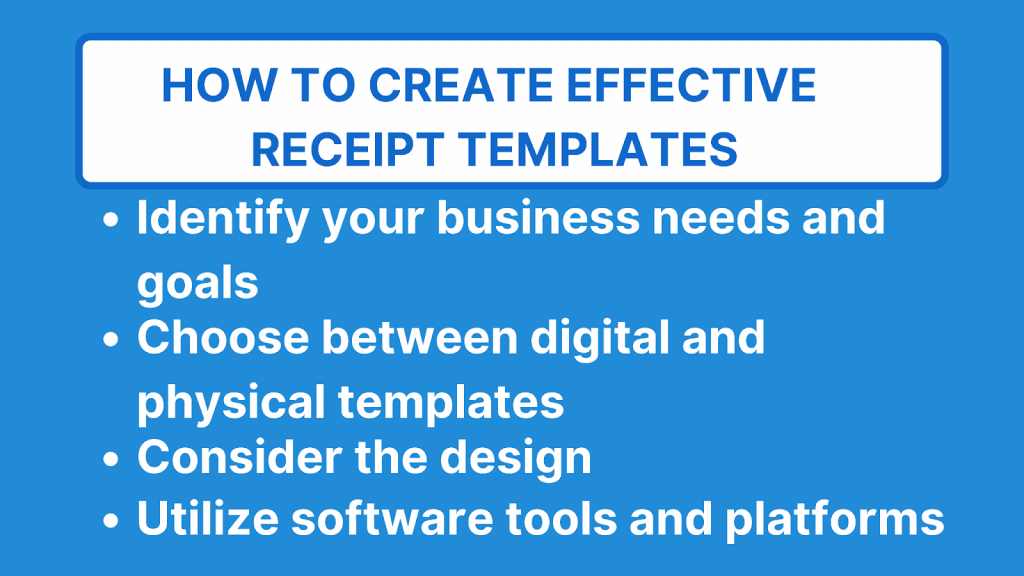In the dynamic world of business transactions, maintaining an impeccable level of organization is paramount. Whether you’re a small entrepreneur or part of a larger corporation, the significance of well-organized receipts can’t be overstated. Clear, concise, and comprehensive records not only facilitate seamless financial tracking but also foster credibility and trust with your clients and partners.
In the following article, we’ll tell you about the mechanics of receipt templates, exploring their components, benefits, and how they can be tailored to suit your unique business needs. This guide will also give you a clue on how to harness the power of receipt templates for a more streamlined and professional business journey.
Contents:
1. Importance of well-organized receipts in business transactions
2. Receipt template’s role in enhancing efficiency and professionalism
3. Why use templates of a receipt?
4. An overview of a receipt template
- Definition and purpose of a receipt template
- PDF template of a receipt
- Using Google Docs for a receipt template
- Common elements of a receipt template
5. How to create effective receipt templates
6. Customizing receipt templates
7. Ensuring legal and compliance standards
- Benefits of transitioning to digital receipts
- Email receipts vs. SMS receipts
- Data security and customer consent
- Organizing and archiving digital receipts for easy retrieval
9. Tips for effective receipt management
Importance of well-organized receipts in business transactions
Imagine a scenario where transactions lack proper documentation. The confusion, disputes, and potential financial losses that can arise from such disarray are all too real. A well-organized receipt serves as the cornerstone of sound financial management. It provides a tangible trail of evidence, substantiating each transaction’s details – from the items purchased to the method of payment.
This receipt acts as a safeguard against discrepancies, ensuring that all parties involved are on the same page. Receipts empower businesses to monitor cash flow, track expenses, and manage tax obligations effectively. Furthermore, in the event of audits or financial reviews, organized receipts can be the difference between a smooth process and a painstaking ordeal.
Check out our article on receipt management apps.
Receipt template’s role in enhancing efficiency and professionalism
Receipt templates are heroes of efficient business operations. A meticulously crafted template of a receipt offers a structured framework for consistently generating receipts. It eliminates the need for manual documentation for every transaction, freeing up valuable time and resources.
A template of a receipt also elevates the professionalism of your business. By adhering to a standardized format, you convey a sense of reliability and attention to detail to your clients. Every receipt becomes a tangible representation of your commitment to providing excellent service and maintaining transparent financial records.
Moreover, such a template enables you to customize your receipt with your business logo, branding elements, and relevant information. This not only reinforces your brand identity but also enhances the overall visual appeal of the receipt, making a lasting impression on recipients.
Why use templates of a receipt?
Receipt templates are more than just convenient tools; they bring a multitude of benefits that can positively impact your business operations, customer relationships, and overall efficiency.
Use a template of a receipt to save time
One of the most immediate advantages of utilizing receipt templates is the significant time saved in generating receipts for each transaction. Manually crafting a receipt from scratch can be labor-intensive and prone to errors. With a well-designed template, all you need to do is input the transaction-specific details, and the template will automatically format the receipt for you. This streamlined process allows you and your team to allocate time to more strategic tasks that contribute to your business’s growth.
Use a template of a receipt to reduce errors and ensure accuracy
Human errors are inevitable, especially when you enter data manually. Receipt templates mitigate the risk of typographical errors, incorrect calculations, or missing information. By providing predefined fields for essential details, templates eliminate the guesswork and reduce the potential for mistakes. This accuracy translates into fewer disputes, smoother audits, and an improved overall financial management process.
Ensuring the accuracy of your accounting
Human errors are a typical bottleneck for businesses, which impedes their growth and success. Use the power of modern technology not only to create a receipt template but also to automate other business processes. Synder Sync is a top-notch software for ecommerce businesses that uses the power of automation to ensure error-free syncing of data it aggregates from your sales channels and payment gateways, and accurately records it into the books. Enjoy seamless accounting without duplicate entries or discrepancies and get your books perfectly ready for a smooth reconciliation!
Synder’s human approach to automation always focuses on the customers’ needs, so Synder is happy to offer you an impressive list of integration with the most popular ecommerce platforms, payment processors, and accounting software, which is regularly updated upon request. Moreover, with Synder, you’re free to choose the necessary data sync mode: Per Transaction – a detailed account of every sales transaction you have during a day (suitable for small businesses that are just setting off on their ecommerce journey), or Daily Summary – as the name suggests, a more general record of all sales data for a day (tailored specifically to larger merchants dealing with big numbers).
Sign up for a free trial or book a spot at our webinar to see how to make full use of Synder to benefit your business.
Use a template of a receipt to boost branding and customization opportunities
Receipt templates aren’t just about presenting transaction details; they’re also an extension of your brand identity. Many templates allow for customization, enabling you to incorporate your business logo, color scheme, and relevant branding elements. This customization reinforces your brand’s visual identity and creates a lasting impression on customers, further enhancing your business’s professional image.
Use a template of a receipt to improve customer experience and trust
Clear and well-structured receipts contribute to a positive customer experience. When customers receive receipts that are easy to read and understand, they feel valued and respected. Transparent receipts that provide comprehensive information about the transaction, along with clear terms and conditions, contribute to building trust between your business and its clients. A trustworthy relationship with customers is essential for long-term success and repeat business.
And now let’s get down to exploring the practical steps involved in creating effective receipt templates. From design considerations to software tools, we’ll tell you everything you wanted to know about crafting templates that align with your business’s unique needs and brand identity. By harnessing these benefits, you’ll be well on your way to enhancing your business’s financial operations and customer interactions.
An overview of a receipt template
A template of a receipt serves as the blueprint for creating structured and organized records of business transactions. This format not only streamlines the process of generating receipts but also enhances the consistency and professionalism of your interactions with clients and customers.
Definition and purpose of a receipt template
A template of a receipt is a predefined form that outlines the structure and content of a receipt. It serves as a time-saving tool that enables businesses to generate accurate and uniform receipts for various transactions. The primary purpose of a receipt template is to provide a standardized framework that captures essential transaction details, ensuring transparency, accuracy, and ease of reference.
PDF template of a receipt
Templates of a receipt have undergone a significant transformation in recent years, largely due to the advancement of technology. Traditional paper-based receipts have given way to digital alternatives that offer a host of benefits. Among these, PDF receipt templates have emerged as a powerful tool, bridging the gap between the tactile reliability of paper receipts and the convenience of digital records.
An Adobe PDF template of a receipt is a special format that encapsulates all the necessary details of a transaction within a digital document. This document can be easily shared electronically, printed for physical documentation, or stored securely in a digital archive. PDF’s universal compatibility ensures that the receipt format remains consistent across different devices and platforms, maintaining the integrity of the receipt’s layout and information.
Using Google Docs for a receipt template
Google Docs provides a user-friendly and collaborative environment for creating various types of documents, including templates of a receipt. Its intuitive interface and array of formatting tools make it an excellent choice for crafting well-designed Google Doc templates that align with your business’s identity and transaction needs.
Common elements of a receipt template
A template of a receipt is thoughtfully designed to encompass all the necessary information relevant to a transaction. Here are the key elements typically found in a well-structured receipt template:
- Header information (business name, logo, contact details): The header of the receipt template prominently displays your business’s identity, including its name, logo, and contact information. This establishes the professional context and provides recipients with the means to reach out if needed.
- Transaction details (date, time, invoice/receipt number): Precise information about the transaction is included, such as the date and time of the purchase. Additionally, an invoice or receipt number is assigned, facilitating easy tracking and referencing.
- Itemized list of products/services with descriptions and prices: This section of a receipt lists each product or service purchased, accompanied by clear descriptions and their corresponding prices. Itemizing the components of the transaction enhances transparency and helps both parties understand what is being billed.
- Subtotal, taxes, and additional charges: The subtotal is the sum of the prices of all items before taxes and additional charges. Taxes, if applicable, are detailed separately, providing transparency in tax calculations. Any extra charges, such as shipping fees or service charges, are also outlined.
- Total amount and payment method: The total amount due is the culmination of the subtotal, taxes, and additional charges. This section also specifies the method of payment chosen by the customer.
- Customer information (name, address, email): Identifying information about the customer, including their name, address, and email may also be included to facilitate effective communication and ensure accurate record-keeping.
- Terms and conditions, return policy, or additional notes: Important terms and conditions, return policies, or any additional notes related to the transaction may be outlined in this section. This ensures that customers are informed about your business policies and procedures.
How to create effective receipt templates
Crafting effective receipt templates requires careful consideration of your business’s unique requirements and a keen focus on design elements that enhance professionalism and functionality.
Identify your business needs and goals
Before delving into the technical aspects of creating a receipt template, it’s crucial to assess your business’s specific needs and goals. Determine the types of transactions you frequently engage in, whether it’s product sales, service charges, or a combination of both. Understand the level of detail your receipts must contain to meet legal requirements and customer expectations. A well-organized gross receipt, whether in digital or physical form, is crucial for maintaining transparency and accuracy in financial transactions
Choose between digital and physical templates
Decide whether your business would benefit more from digital or physical receipt templates. Digital templates offer flexibility and ease of distribution via email or SMS, while physical templates can provide tangible documentation for in-person transactions.
Consider the design
- Simple and clean layout: Keep the layout of your receipt template straightforward and clutter-free. A clean design enhances readability and ensures that essential details are easily identifiable.
- Aligning with brand identity: Incorporate your business’s logo, color palette, and design elements that align with your brand identity. This fosters a consistent visual experience across all interactions.
- Legible fonts and clear typography: Opt for legible fonts that ensure the text is easily readable. Clear typography contributes to a professional appearance and prevents any confusion.
- Strategic use of colors: Use colors that resonate with your brand and evoke the desired emotions. However, ensure that the color scheme doesn’t compromise readability or distract from the transaction details.
Utilize software tools and platforms
- Microsoft Word or Excel: These widely used software applications offer customizable templates for creating receipts. While not specifically designed for receipt generation, they can be a convenient starting point.
- Online receipt generators: Various online platforms provide user-friendly receipt generator tools. These platforms often allow customization of fields, fonts, colors, and even logos, making the process quick and hassle-free.
- Accounting and invoicing software: Many accounting and invoicing software solutions include built-in receipt template options. Utilizing such software not only streamlines the receipt creation process but also integrates it with your broader financial management system.

In short, if you blend an understanding of your business needs, design aesthetics, and appropriate software tools, you can develop receipt templates that seamlessly integrate into your operations.
Customizing receipt templates
Personalizing receipt templates allows you to infuse your brand’s identity and tailor the content to suit various transaction scenarios. By making these templates uniquely yours, you enhance both the aesthetic appeal and the practicality of the receipts.
Incorporating your business logo and branding elements
The inclusion of your business logo and branding elements in the receipt template solidifies the connection between the transaction and your brand. A prominently placed logo serves as a visual reminder of your professionalism and helps recipients associate the receipt with your business. Ensure that the logo is appropriately sized and positioned for a balanced and appealing layout.
Adding specific terms, policies, or notes
Customize your receipt templates to include specific terms, policies, or notes that pertain to your business and the transaction. Whether it’s a return policy, payment terms, or special offers, these additional details offer transparency and clarity to both you and your customers. Custom notes can also convey appreciation or personalization, contributing to a positive customer experience.
Adapting templates for different types of transactions
Your business may engage in a variety of transactions, each with its own nuances. Adapt your receipt templates to cater to different scenarios such as sales, services, and returns. For instance, a service receipt might highlight the type of service provided and the associated hourly rates, while a sales receipt would focus on products and quantities. This adaptability ensures that your templates remain relevant and useful across diverse transaction types.
Integrating QR codes, barcodes, or links for digital receipts
In the digital age, incorporating QR codes, barcodes, or links into your receipt templates can add an interactive dimension. These elements can lead recipients to digital copies of their receipts or provide direct access to online customer support. For digital receipts, including QR codes or barcodes can facilitate easy retrieval and reference, enhancing the customer experience.
As you customize your receipt templates, remember that a well-tailored template not only enhances the professionalism of your transactions but also reinforces your brand’s identity. In the subsequent section, we will delve into the legal and compliance considerations you should keep in mind while designing and distributing receipts. These guidelines are essential to ensure that your customized receipts adhere to relevant regulations and standards.
Ensuring legal and compliance standards
While customization offers creative freedom, it’s essential to balance it with adherence to legal and compliance standards. Receipt templates must contain specific information, follow tax regulations, and respect data protection considerations to avoid legal pitfalls.
Including mandatory information (tax details, registration numbers)
Receipts must include mandatory information to ensure accuracy and transparency in financial transactions. This includes tax details such as VAT or GST, as well as any registration numbers required by your local tax authority. Failing to include this information may result in penalties and legal complications.
Adhering to local tax laws and regulations
Tax laws can vary significantly depending on your location and the nature of your business. Ensure that your receipt templates are aligned with local tax laws and regulations. This includes accurately calculating and displaying taxes, as well as indicating tax-exempt transactions when applicable. Staying compliant with tax laws builds trust with customers and prevents potential legal disputes.
Addressing privacy and data protection concerns
Incorporating customer information into receipt templates comes with responsibilities regarding privacy and data protection. Ensure that you comply with data protection regulations such as GDPR (General Data Protection Regulation) or CCPA (California Consumer Privacy Act), depending on your business’s jurisdiction. Avoid including sensitive customer data on receipts, and clearly communicate how customer information will be used and protected.
Moreover, if you plan to store digital receipts or share them electronically, it’s crucial to implement secure data storage practices and encryption protocols to safeguard customer data from unauthorized access.
By adhering to legal and compliance standards, you not only protect your business from potential legal consequences but also demonstrate your commitment to ethical business practices. As we proceed to the next section, we will explore the advantages of transitioning to digital receipts and how to manage them effectively to optimize your receipt management process.
Managing digital receipts
In an increasingly digital world, the management of receipts has evolved alongside technology. Transitioning to digital receipts offers several advantages, but it also comes with considerations related to data security, customer preferences, and efficient organization.
Benefits of transitioning to digital receipts
The shift to digital receipts brings a range of benefits that contribute to streamlined operations and enhanced customer experiences. Digital receipts are environmentally friendly, reducing paper waste. They’re also more easily accessible, as customers can retrieve them from their email or messaging apps. Additionally, digital receipts can integrate with customer relationship management (CRM) systems, providing valuable data for analyzing purchasing behaviors and tailoring marketing efforts.
Email receipts vs. SMS receipts
When transitioning to digital receipts, businesses can choose between email receipts and SMS receipts.An email receipt offers a more detailed format with the potential to include additional information and branding elements. An SMS receipt, on the other hand, is concise and convenient, making it suitable for quick transactions. Consider your audience’s preferences and the nature of your business when deciding which option of receipt to implement.
Data security and customer consent
As digital receipts involve the collection and storage of customer data, it’s crucial to prioritize data security. Implement encryption methods to protect customer information from unauthorized access. Furthermore, customer consent is paramount – ensure that customers explicitly agree to receive digital receipts and understand how their data will be handled.
Organizing and archiving digital receipts for easy retrieval
Efficiently managing digital receipts involves organizing and archiving them for easy retrieval. Implement a structured naming convention for digital receipt files and utilize folders or tags to categorize receipts by date, type of transaction, or customer. Cloud storage solutions can be invaluable for securely storing and accessing digital receipts from various devices and locations.
Remember, the convenience of digital receipts is contingent on their accessibility. Ensure that your customers can easily access and retrieve their digital receipts whenever they need them.
Tips for effective receipt management
Efficient receipt management goes beyond the initial creation of templates. By implementing these practical strategies, you can ensure that your receipt management process remains organized, up-to-date, and aligned with the evolving needs of your business and customers.
Tip#1: Regularly update and revise templates
Receipt templates should evolve alongside your business. Regularly review and update your templates to accommodate changes in pricing, products, services, and any alterations in legal requirements. By keeping your templates current, you avoid discrepancies and ensure that customers receive accurate and relevant information.
Tip#2: Store templates in a centralized location
Maintaining a centralized repository for receipt templates streamlines accessibility and minimizes the risk of outdated versions being used. This centralized storage ensures that all team members have access to the most recent templates and reduces the potential for confusion or errors.
Tip#3: Train staff on correct usage and customization
Ensure that your team is well-versed in using and customizing receipt templates. Provide training on inputting accurate transaction details, making necessary modifications, and personalizing receipts as per customer preferences. A well-trained staff contributes to consistent and professional interactions with clients.
Tip#4: Seek customer feedback for continuous improvement
Customers’ experiences with your receipts can offer valuable insights. Actively seek feedback from your customers on their receipt experience – whether they found the details clear, whether the formatting was user-friendly, and if any improvements could be made. This feedback loop enables you to refine your receipt templates and create an even more satisfying customer experience.
Overall, effective receipt management is a dynamic process that requires attention to detail, adaptability, and a commitment to professionalism. By incorporating these tips into your receipt management strategy, you’re well-positioned to enhance customer trust, streamline operations, and present your business in the best possible light. Through consistent refinement and a customer-centric approach, your receipt templates can become powerful tools for fostering positive business relationships and driving success.
Final words on creating and managing receipt templates
In the intricate landscape of business transactions, the utilization of receipt templates emerges as a strategic advantage that transcends mere documentation. Receipt templates extend a series of advantages that reverberate across your business operations. From saving invaluable time through automation to fostering consistency and professionalism, these templates of receipts have proven to be catalysts for error reduction, brand enhancement, and improved customer trust. By embracing these templates, you position your business on a trajectory that optimizes efficiency while cementing credibility.
The potential for business growth is, no doubt, intertwined with the adoption of receipt templates. By customizing a template of a receipt to encapsulate your brand identity, transaction specifics, and compliance standards, you not only improve operations but create avenues for deeper customer engagement.
From digital receipts that reduce paper waste to customizable software tools that expedite the process, technology plays a pivotal role in modernizing receipt management practices. This shift allows businesses to adapt to changing consumer preferences and regulatory landscapes while fostering seamless interactions with clients.
As you embark on this journey of integrating receipt templates into your business framework, remember that these templates are representations of your commitment to precision, transparency, and professionalism. By crafting, customizing, and managing these templates with care, you unlock the potential to revolutionize your business interactions with customers and foster sustainable growth in your industry.
Here’s our recommended list of articles that will help you learn more about templates:







.png)
